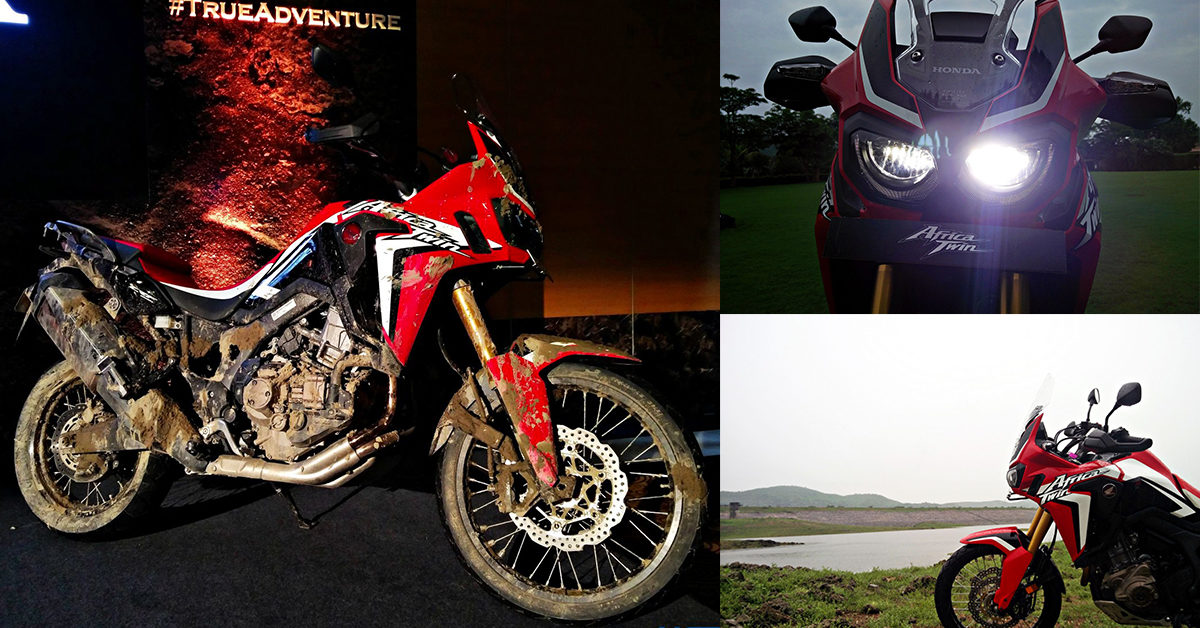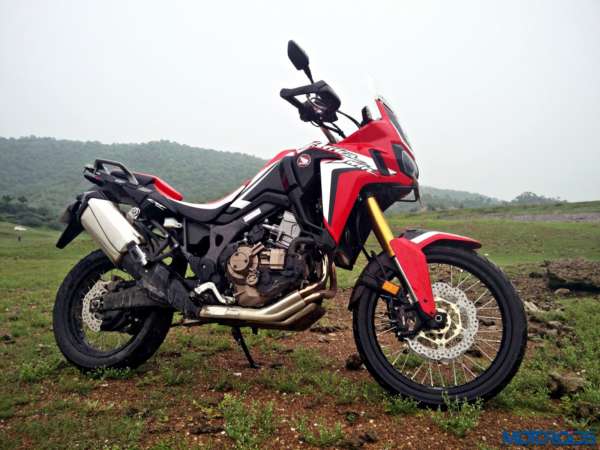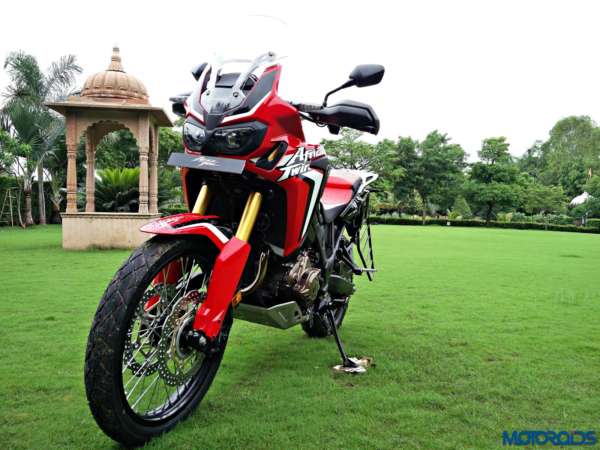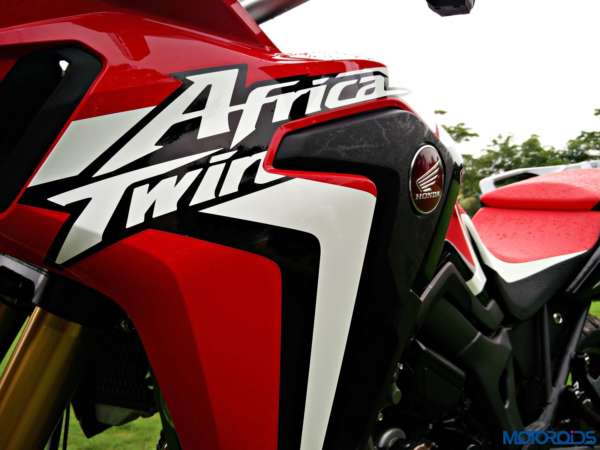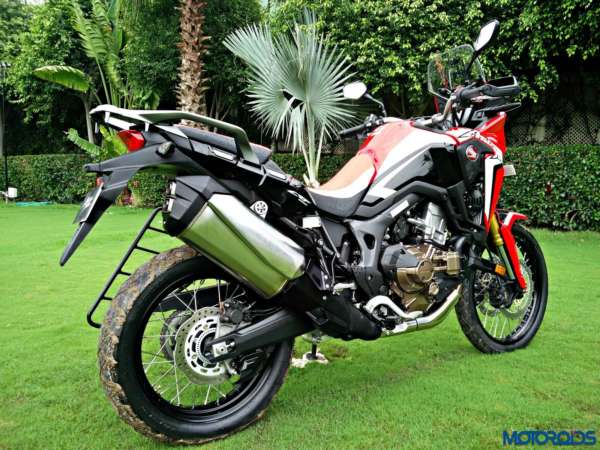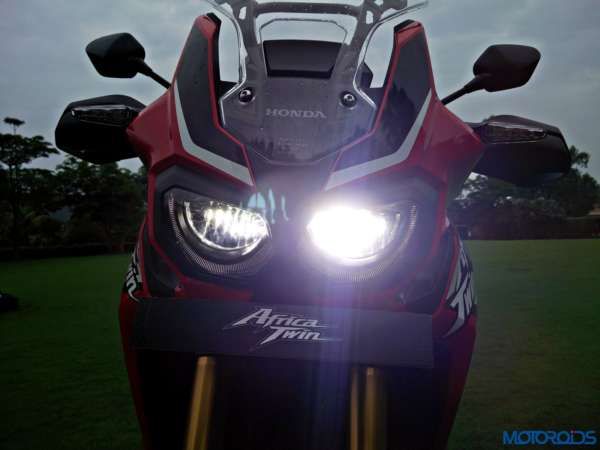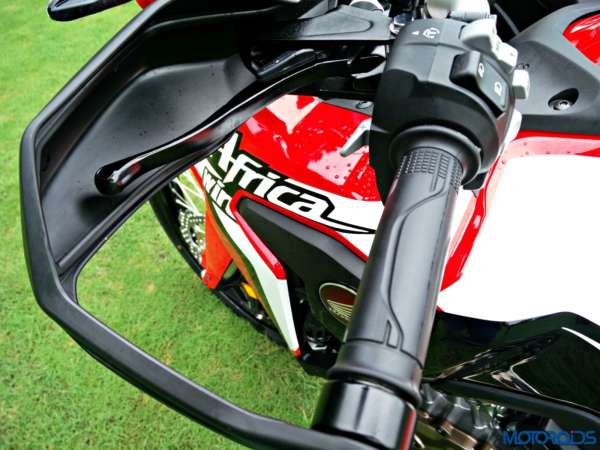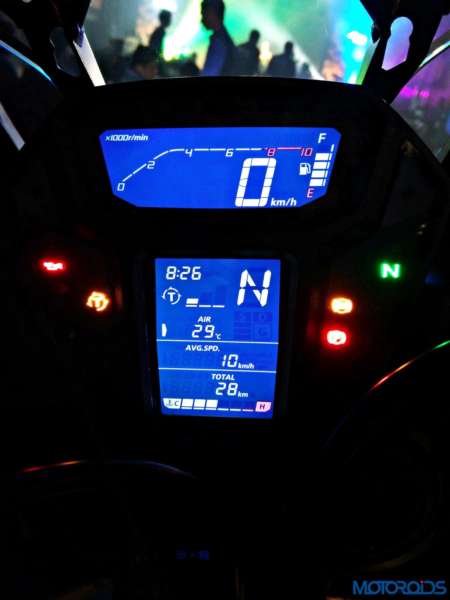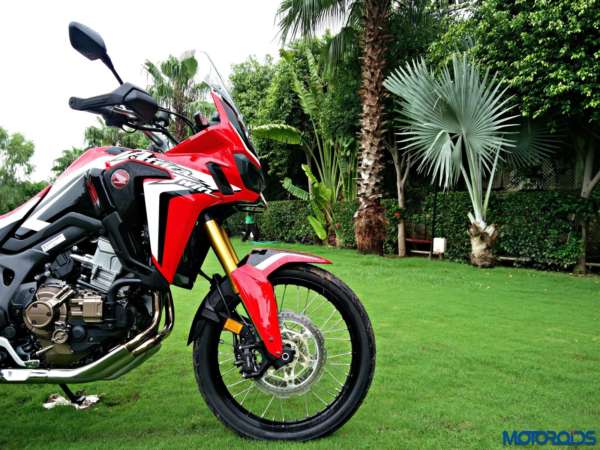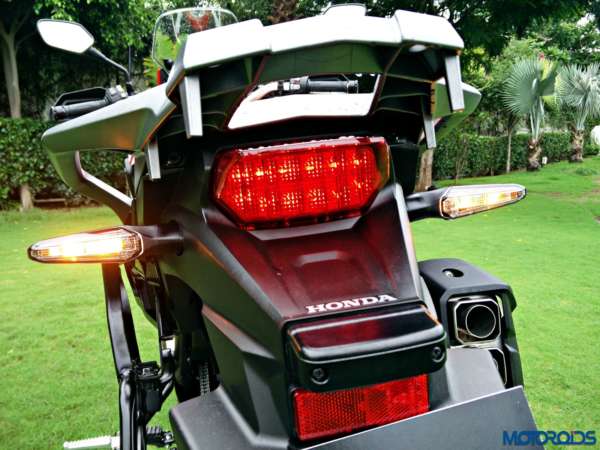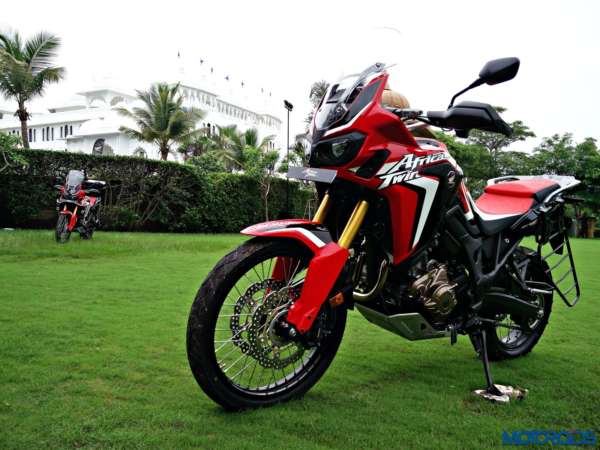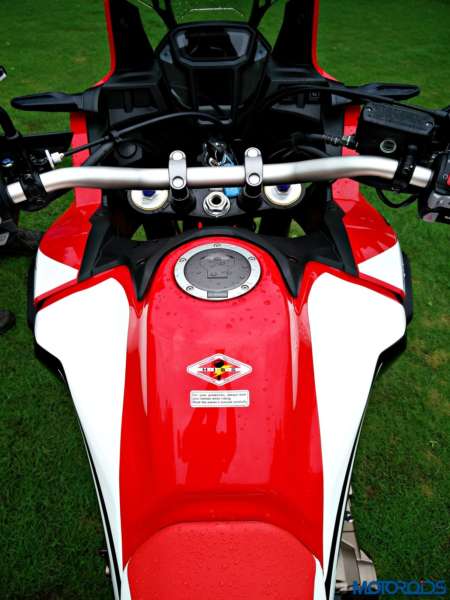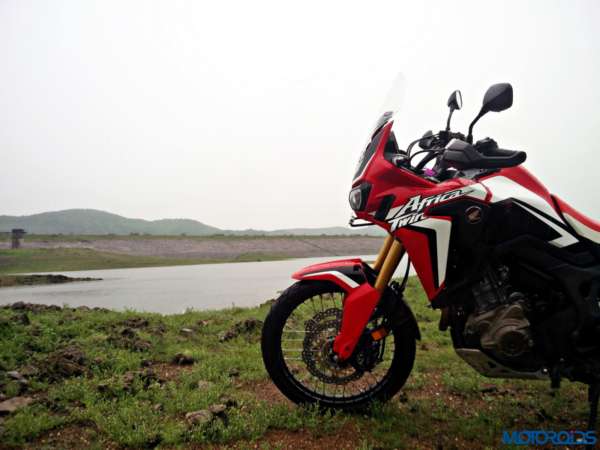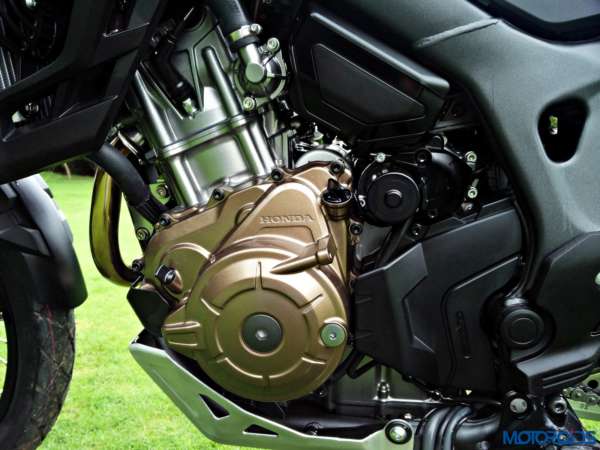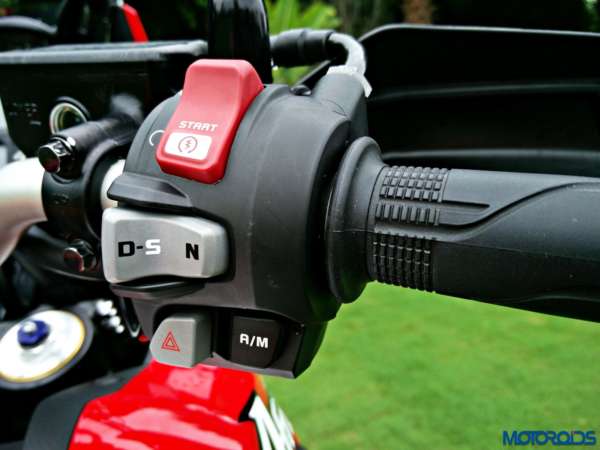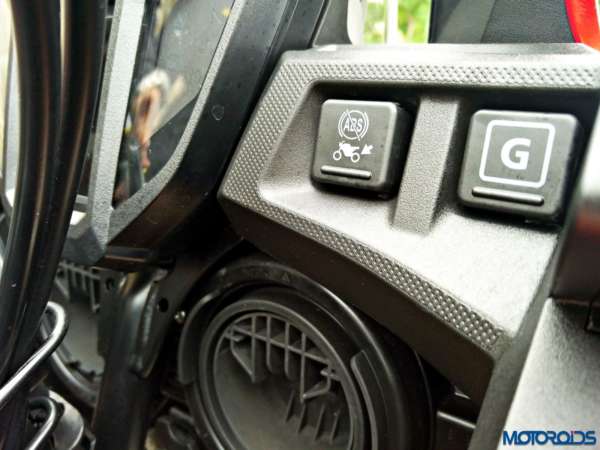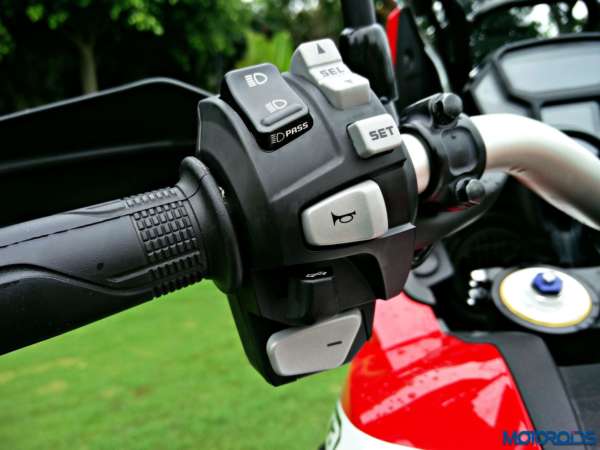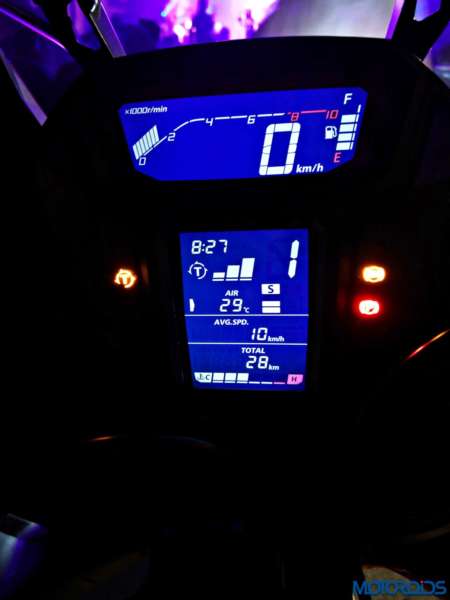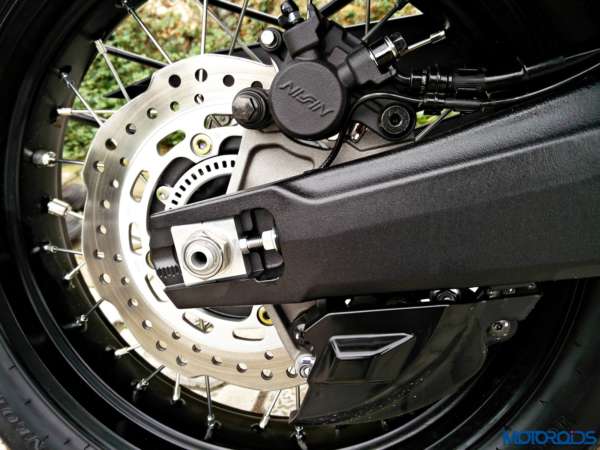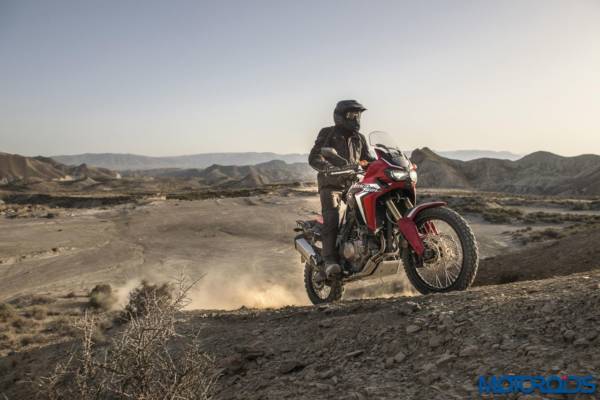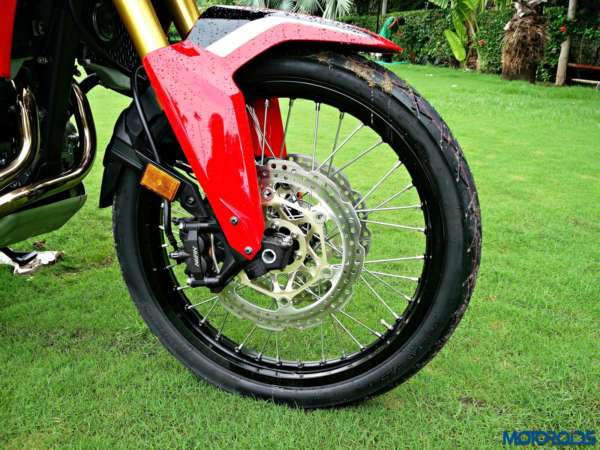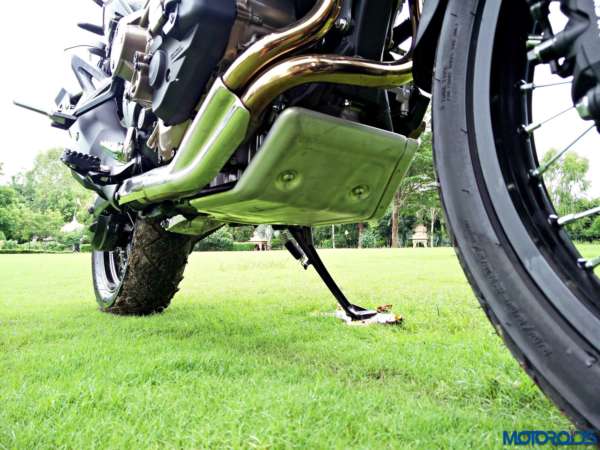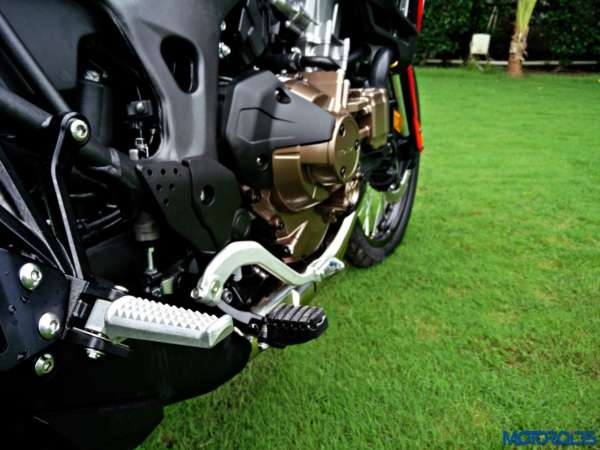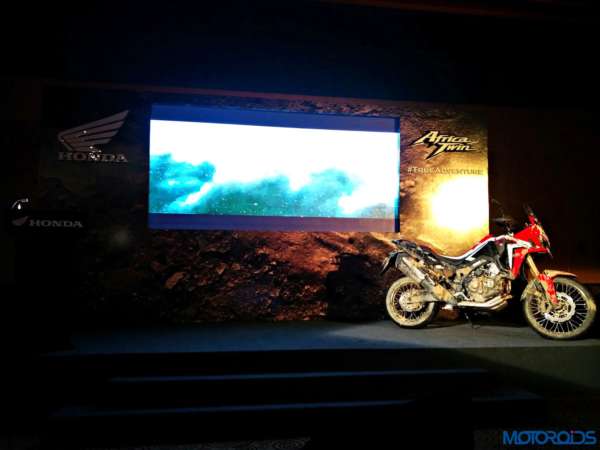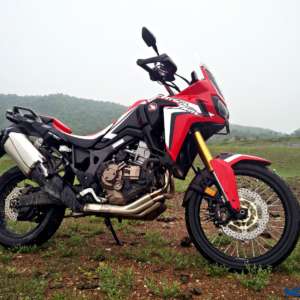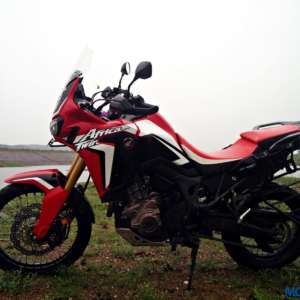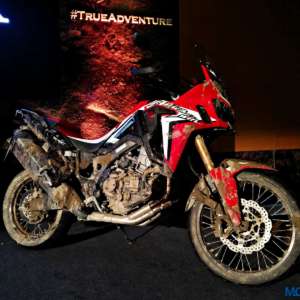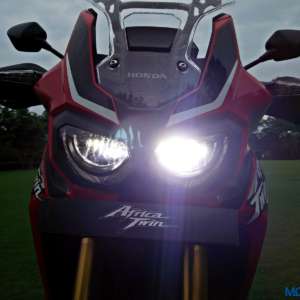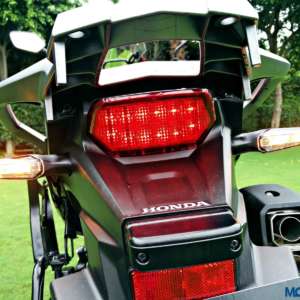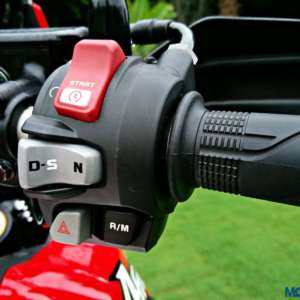I have been in this argument of sorts with myself where one part of me absolutely adores big adventure motorcycles; their sheer size, presence, power and capabilities clubbed with an extensive electronic package that makes them explosive off the tarmac and very, very usable on it. Then there is the other side, the practical one, the one that puts logic before love, which questions the need of these machines in the first place. I’ve had the best time aboard the Ducati Multistrada 1200 Enduro but I’d have to admit that I’ve had a tough time in the parking lot and some agony in bumper-to-bumper traffic. It’s been the case with almost every large-sized adventure tourer motorcycle that I’ve tested in my three-year long stint with Motoroids. Most of the woes were owing to the tall seats that tested every inch of my 5’9” height, not to mention the relatively heavy weight and enormous girth these motorcycles carry.
We have the Triumph Tiger range, the Ducati Multistrada 1200 Enduro and the latest to enter the market, the BMW R1200 GS in India but something seems to be missing here. As you must’ve guessed, we don’t have a Japanese contender to complete the list. Sure, we’ve got the Kawasaki Versys 1000 and the Suzuki V-Strom 1000 but with the alloy wheels, they aren’t supposed to go mud bashing. We’re yet to hear anything about the new 2017 Suzuki V-Strom 1000 XT’s possible arrival in the Indian market.
But the Japanese are no longer absent in the true blue adventure motorcycle space. Honda Motorcycles and Scooters India brought the Japanese in the adventure motorcycling segment of the Indian two-wheeler market and it came with a big bang, the CRF1000L a.k.a the Africa Twin. To spice things up, Honda brought in the Dual Clutch Transmission or the DCT version of the litre-class adventure tourer. Is the bang big enough to change the “bigger is better” approach of the Indian consumer? Honda invited motoring journalists from across India to the City Of Lakes, the Venice of the East or the Kashmir of Rajasthan, Udaipur, to experience their product that is named after world’s second-largest continent.
Honda CRF1000L Africa Twin Design
I’ve always had a special thing for Africa. It’s possibly because I’ve spent countless hours of my childhood watching the picturesque Savannah on the Discovery Channel, or probably because one of my all time favourite films is the South African comedy, The Gods Must Be Crazy. I cannot point at one particular reason. But what’s a mesmerising view on the tube, is one of the most challenging survival conditions on the planet. Africa is home to the world’s largest desert, the Sahara, which is almost as big as the United States. Then there are the Namib and the Kalahari deserts.
So any machine that carries the Africa tag should be designed to survive the diverse geography of the continent. The Africa Twin does that just about right. Unlike every other adventure motorcycle on the block (in India), the Africa Twin gets a lean design. It’s one of the most compact adventure motorcycles in the premium segment on the Indian soil today.
Honda has retained the dual headlight layout of the original Africa Twin, the XRV 750, but it added a pinch of future to the illuminator. Illuminating the path for rider is a pair of LED headlights. They’re not spherical like the XRV 750 but they get the curves. The black borders of the headlight give the new Africa Twin an aggressive fascia. The long travel suspension offers commendable clearance between the front fender from the headlight, in case you decide to go airborne. Just above the LED headlight is a pair of LED blinkers, placed on the edge of the fairing. On top is a non-adjustable windscreen that offers some solace from the windblasts. Tall riders may have to opt for the optional, high windscreen that’s available as an accessory. It offered pretty decent protection during our stint with the motorcycle in Udaipur but I honestly missed the Ducati Multistrada 1200 Enduro’s easy to adjust wind protector.
Venture slightly further and you’d notice a pair of sturdily built knuckle guards which come as standard. The easily accessible switchgear makes life easy although it’d take a few miles to get accustomed to the left side of the handlebar. Being equipped with DCT gearbox, the motorcycle does not feature a clutch lever but you’d find “Lever-Lock” parking brake system which keeps the Africa Twin stationary and comes especially handy while parking on incline roads.
Behind the fairing is a rally style LCD instrument console that is divided into three parts. The top-most part displays the basic information like the tachometer, speedometer and fuel gauge. The lower part provides information about the gear engaged, traction control level, riding mode, odometer, two trip meters, average speed, average fuel consumption, engine coolant temperature, air temperature and a clock. The telltale indicators, including the ABS mode and parking brake indicator are positioned on either side of the display. The display offers good amount of visibility although you’d have to be sitting on the saddle to read it properly. A slightly tilted angle would’ve provided better visibility while standing up on the footpegs.
The semi-fairing merges onto the lean fuel tank. It isn’t a massive platter to serve the litre-class parallel twin engine but it does a decent job. At 18.8 litres, it isn’t the biggest fuel tank in the market but with a claimed fuel economy of 21.5 kmpl, the overall range works out to roughly above 400 kms. We’re sure better conservation in manual mode will help riders squeeze out more miles to a gallon and improve the overall range.
Following the fuel tank is one of my favourite bits on the motorcycle, the seat. Internationally, the Africa Twin is available with a seat height of 870 mm (adjustable to 850 mm). The India spec model, however, comes with an 840mm seat (adjustable to 820 mm) which means better access to the terra firma and easier steering in parking. Say hello to ground with both feet! We’d talk more about the comfort in the ergonomics section.
At the rear is a massive pillion grab-rail which doubles up as the mounting for a top box and can carry upto 10 kg of weight. A rather simple looking LED tail-light accompanied by LED blinkers give the Africa Twin a subtle finish at the rear. On the side, you can see the tall-set exhaust that emanates some sweet melodies at high revs. Tall placement means that you can wade through a decent depth of water too, if need arises. Under the engine is a sump guard that comes as standard and is aimed to protect the parallel twins from any elements that you may encounter off the tarmac. The Africa Twin is built around a solid double-cradle chassis which gives great stability on and off the road.
The build quality is commendable. We saw a couple of our fellow comrades go down on soggy/muddy grounds and the motorcycle escaped almost unscathed, with absolutely no signs of damage on the body panels. I’d like to add here that the media motorcycles were NOT equipped with the optional crash guards. The motorcycle is available only in Red colour that, from the saddle, reminds of a particular Italian motorcycle. I would’ve liked to see the white paint option available too. We’d probably see that when the next batch arrives.
What I absolutely admire is the lean design, commendable build quality and the easy accessibility to ground thanks to the 820 mm saddle. It ticks all the right boxes for someone who’s looking for a functional adventure motorcycle. It has quite a road presence too and we’d spot curious eyes and excited kids waving at us every now and then.
Check out the Honda Africa Twin DCT in detail:
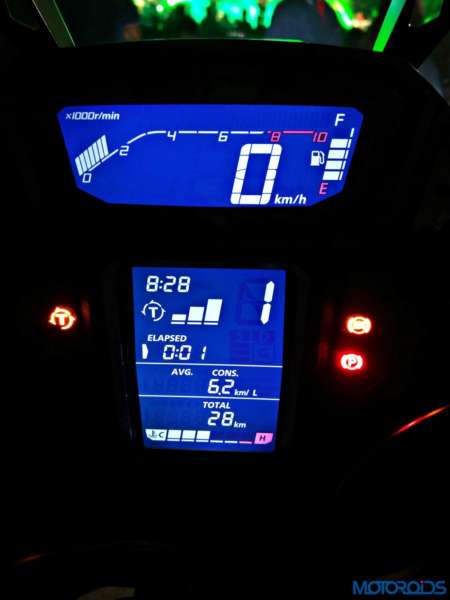
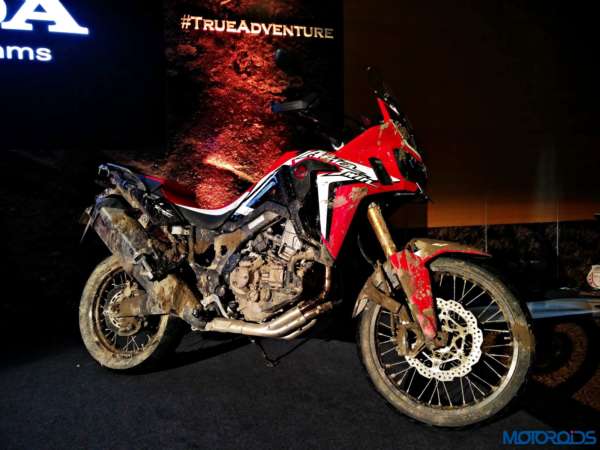
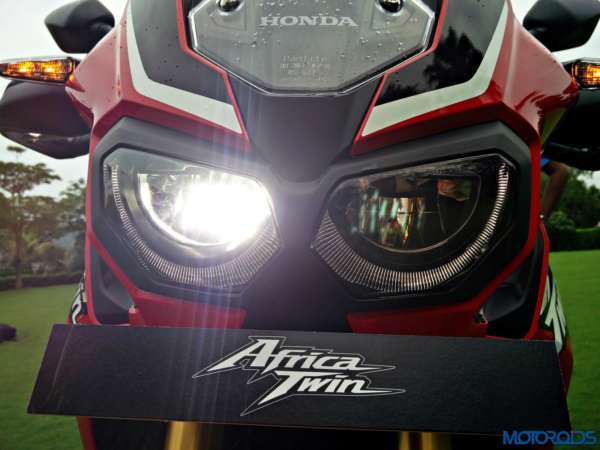
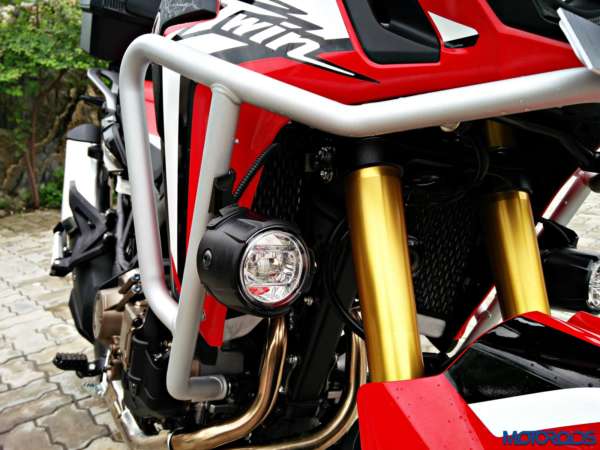
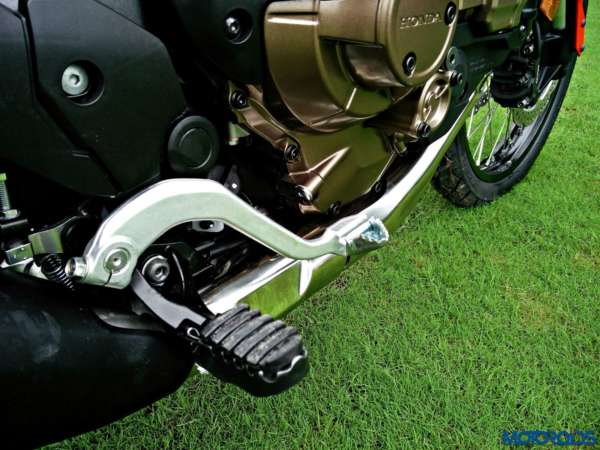
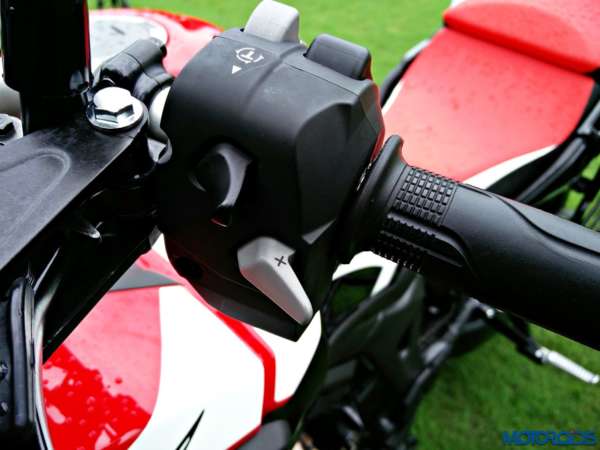
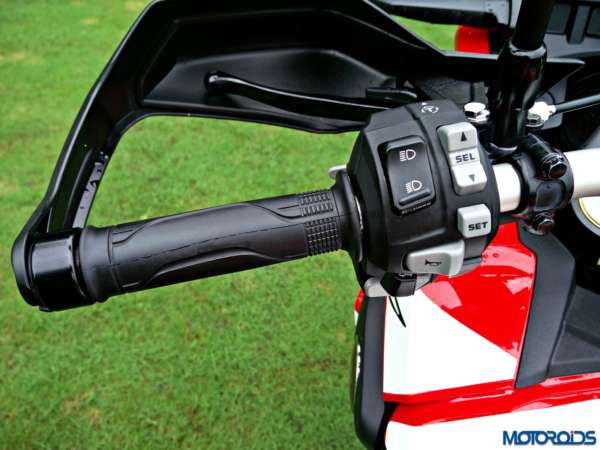
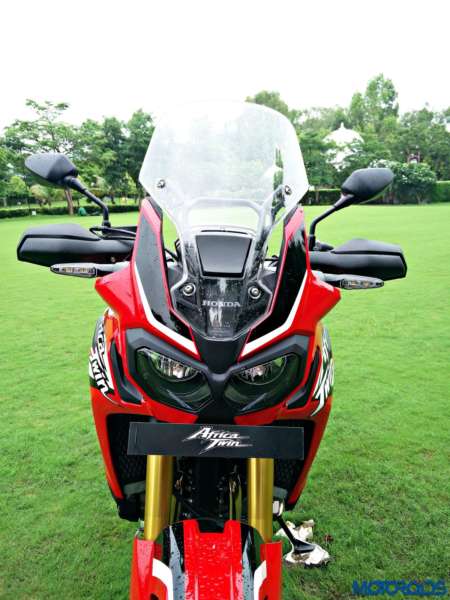
How does it ride?
Honda CRF1000L Africa Twin Engine, Electronics and Performance
Do you know how car people rave about driving a stick but eventually find admiration in the precision of the DSG gearbox? It was a somewhat similar experience with the Africa Twin. I’ve grown up riding manual transmission motorcycles. In fact, I never swung a leg over an automatic transmission scooter during the learning days and seldom do it even today. So with absolutely no experience of DCT (Nope, I never really got a chance to ride the Honda VFR1200) it took me a few moments to soak in the missing clutch and gear lever.
Before we talk about the gearbox in detail, let’s get the technical specifications out of the way. The 999cc parallel twin, liquid cooled engine delivers maximum power of 87 Bhp @ 7500 RPM and peak torque of 91.9 Nm @ 6000 RPM. Honda says that the engine is equipped with the same 4-valve Unicam head design as its the CRF range. The engine comes mated to a Dual Clutch Transmission or DCT. DCT, as the name suggests, features two clutches where one operates 1st, 3rd and 5th gears while the other operates 2nd, 4th and 6th.
The transmission depends on selected drive mode. The right-side controls provide access to switch selection of ‘N’ (Neutral), ‘D’ (Drive) or ‘S’ (Sport) riding modes. The D mode, for instance, is focused on long distance touring. In D mode, the motorcycle upshifts as soon as the rev band crosses 4,000 RPM. The S mode, which is divided in three sub modes, lets the engine rev slightly higher. In S1 mode, the transmission would upshift at 5,000 revs. In S2, the gearbox would climb to a higher gear at 6,000 clicks. In S3 mode, you’d find that the engine would rev all the way to 7,000 RPM before upshifting, thus letting you enjoy the powerband. The MT manual mode allows you to control the gear shifts and you can stretch the Africa Twin all the way to its redline of 8,000 RPM. Switching from automatic to manual is just a press of a button away. The A/M switch which sits right on the right side, next to the hazard light switch, toggles between automatic and manual transmission.
Then there is the G mode that is tuned for off-road riding. The big square G Switch that sits next to the equally large ABS button on the dash provides half-clutch control that is designed to respond directly to throttle operation which is a blessing when going off the road. The ‘G’ switch improves traction throughout the modes although Honda recommended us to use the MT mode off the road. The G mode also features incline detection feature in case you plan to take on the big sand dunes, or climb up a steep surface.
The word “premature” does not really go well with men, and an early gearshift is the second worst thing. What’s the first? Go figure. I found the gears to shift in the upper cog at revs as low as 3,000 clicks on a couple of occasions. Thankfully, you can correct that at a click of a button. Just click the minus (–) switch near your left thumb and the gearbox would get in your desired cog. In manual mode, you’d have to be cautious about not going below 2,000 clicks as it engine feels relatively uncomfortable below that mark. It pulls cleanly anywhere above 2,000 revs with a noticeable step up in acceleration above 6,000 revs mark, all the way to the redline.
The top speed is rated at 190 kmph, 90 kmph of which can be achieved in the first gear itself. We could not test the upper limits of all the gears as road was filled with aerodynamic experts who’d trade the rear view for less drag and “better fuel economy”. We’d leave the cattle, stray animals, pedestrians and potholes out of the discussion here. Given my preference for manual transmission, I had most fun in the Manual mode although I’d any day opt for the S modes – S2 to be specific – for city riding.
You wouldn’t find a comprehensive electronic package on the Africa Twin so there is no active suspension, or cornering ABS but that really isn’t a deal breaker. Call me old-fashioned but I like to have minimum electronic intrusion and the Africa Twin ticks all the right boxes for me. Going through the electronics isn’t too difficult either and – except for ABS – riding modes, and Honda Selectable Torque Control (HSTC) can be adjusted on the fly. You get three levels of HSTC and it can be turned OFF altogether. Dual channel ABS is available in two settings only – ON / OFF. In OFF position, it’s the rear ABS that’s disabled, which comes handy for quick direction changes off the road. The front brake ABS is always active. Switching between ON and OFF setting takes a push of the big square button right next to the instrument console. It’s that simple.
Stopping power is provided by wave style dual 310mm, floating discs with Nissin 4-pot radial calipers upfront and a 256mm with a 1-pot calliper at the rear. The response is sharp and precise and I really could not ask for more bite from the Nissin callipers. As aforementioned, the rear ABS can be switched off.
It runs like a well-tamed stallion and the throttle response would entertain you instead of making you scream for your mother. The good amount of torque delivery anywhere above the 2,000 RPM and the ease of operations thanks to the automatic transmission make the Africa Twin a perfect package. I did face a couple of premature gear upshifts but then making corrections wasn’t difficult either. Honda hasn’t brought the standard version of the Africa Twin to India yet but the DCT version, with its MT mode, makes up for that void. Spend some time with it and you’d never want to go back to manual transmission ever again. Things get even better with handling and ride quality.
Honda CRF1000L Africa Twin Handling
Lean styling, stable double-cradle chassis, centralised mass and low centre of gravity makes Africa Twin an absolute treat in the handling department. The 21-inch front would roll over any obstacle off the road. Show it a series of bends and Africa Twin’s cornering ability would fairly impress you, although I’d prefer a firm setting for a day around the canyons. The Dunlop tyres were decent on the road – even in wet conditions – but I’d preferred to have a pair of knobby tyres for trail riding. On the down side, the tyres are tube type so you’d better learn to fix punctures unless you want to be stranded away from civilisation.
One of the USPs of the Africa Twin, as I said in the earlier part of the review, is its seat height. Unlike its rivals, the Africa Twin gets one of the lowest saddles in the adventure motorcycle segment. The seat height of 820 mm makes terra firma easily accessible, even for folks who aren’t as vertically blessed as others. Moving the motorcycle around in parking lot or bumper-to-bumper traffic was far easier than any other adventure motorcycle I’ve ridden in the past. The low seat height does not mean that Honda has compromised on the ground clearance. At 250 mm, the ground clearance is taller than many of the big adventure motorcycles and you really don’t have to worry about anything scraping the underbody of the motorcycle.
Honda CRF1000L Africa Twin Ride Quality
We rode the motorcycle for 90 km, which cannot really be termed as a long ride but we didn’t have any complaints throughout the day. I wouldn’t call the saddle plush but it’s sufficiently padded to give your rear adequate comfort. The windscreen provided some solace from windblasts but I could still feel some amount of beating. You can’t adjust the level which was bit of a letdown and if you want a taller unit, you’d have to shell out extra moolah for the accessory screen.
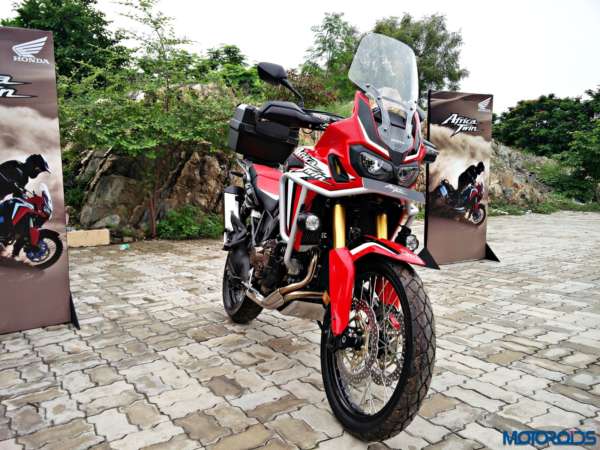
Standing on the footpegs feels natural and the rear-view mirrors do not obstruct the forearms while going off-road. The narrow design overall and the lean fuel tank means you get good amount of space to move around while off-roading. The saddle is designed in such a way that you sit in the bike rather than on it. The refinement levels were typical Honda and the vibrations were next to non-existent.
Suspension duties are performed by Showa 45mm cartridge-type upside down telescopic fork upfront with 230mm travel; and a monoblock with 220 mm at the rear wheel. Both feature dial-style adjusters. The suspension setting, on default setup, soaked in the undulations and pot holes with ease although I’d prefer a firm tuning for a day around the canyons. As aforementioned, the Africa Twin does not get an electronic suspension like the big adventure motorcycles and you’d have to rely on your tools to tune the settings.
Honda CRF1000L Africa Twin Verdict
Should you buy it? Y-E-S says yes. Honda deserves a big round of applause for what they’ve done with the Africa Twin DCT. Off-roading can take a toll and I’ve got a good amount of body ache, I haven’t slept properly for the last three days and a baby in the row behind on the airplace almost made my ears bleed and yet, if given an opportunity, I’d hop on the Honda Africa Twin in a heartbeat and ride into the horizon. It’s one of the most functional motorcycles in the Indian market today. It’s lean, dons perfect saddle height for an average Indian motorcyclist and offers just the right amount of electronics. The DCT gearbox will bid adieu to woes to clutch issues during city rides while the MT mode will give you all the joys of a manual gearbox with the precision of a quickshifter. The 18.8-litre fuel tank may not seem enough for long distance riding but that’s a small trade I’m willing to make for the compact design.
The first seven minutes of the 1980s South African comedy that I mentioned before, The Gods Must Be Crazy, speak about everything that’s wrong with our “routine” lives and how we’ve become prisoners of our own plans. If I were to break away from this prison, the Africa Twin would most likely be among my top escape tools. At about INR 12.9 lakh (ex-showroom), the Africa Twin is one of the most affordable adventure tourers in the Indian market. At that price point it’d give tough time to middleweight adventure motorcycles in India. Lastly, with KTM’s 790 Adventure motorcycle nowhere in sight for Indian market, the Africa Twin will enjoy its time here.
Here are the complete technical specifications:
| Engine | |
| Type | Liquid Cooled, 4 stroke, SI Engine |
| No. of cylinder | Two |
| Displacement | 999.11 cc |
| Max net power | 87 BHP @ 7500 rpm |
| Max net torque | 91.9 Nm @ 6000 rpm |
| Bore x Stroke (mm) | 92.000 x 75.148 |
| Compression ratio | 10.0:1 |
| Valve system | Overhead Camshaft (OHC) Type |
| Fuel system | Fuel Injection |
| Clutch Type | Dual Clutch Transmission |
| Number of Gears | 6 |
| Max Speed | 190 kph |
| Body Dimensions | |
| Length | 2334 mm |
| Width | 932 mm |
| Height | 1478 mm |
| Wheel base | 1574 mm |
| Ground clearance | 250 mm |
| Seat Height | 840mm-820mm (Adjustable) |
| Kerb weight | 245 Kg |
| Fuel tank capacity | 18.8 Ltrs |
| Frame & Suspension | |
| Chassis | Semi Double Cradle |
| Front Suspension | Showa 45mm cartridge-type inverted (Upside Down) telescopic fork with dial-style preload adjuster and DF adjustment, 230mm wheel travel. |
| Rear Suspension | Monoblock cast aluminium swing arm with Pro-Link with gas-charged damper, hydraulic dial-style preload adjuster and rebound damping adjustment, 220 mm rear wheel travel. |
| Tyres & brakes | |
| Tyre size (front) | 90/90-21M/C 54H |
| Tyre size (Rear) | 150/70R18M/C 70H |
| Tyre type (front) | Tube Type |
| Tyre type (rear) | Tube Type |
| ABS System Type | ABS 2-Channel with rear ABS Off Switch |
| Brake type & size (front) | 310mm ‘wave’ style, twin floating front discs with Nissin 4-pot radial callipers |
| Brake type & size (rear) | 256mm ‘wave’ style with a 1-pot caliper |
| Electricals | |
| Battery | 12V 11.2A-h |
| Head lamp (LED) | Hi 17W X 1, Low 18W X1 |
| Price (ex-showroom) | INR 12.9 Lakh |

